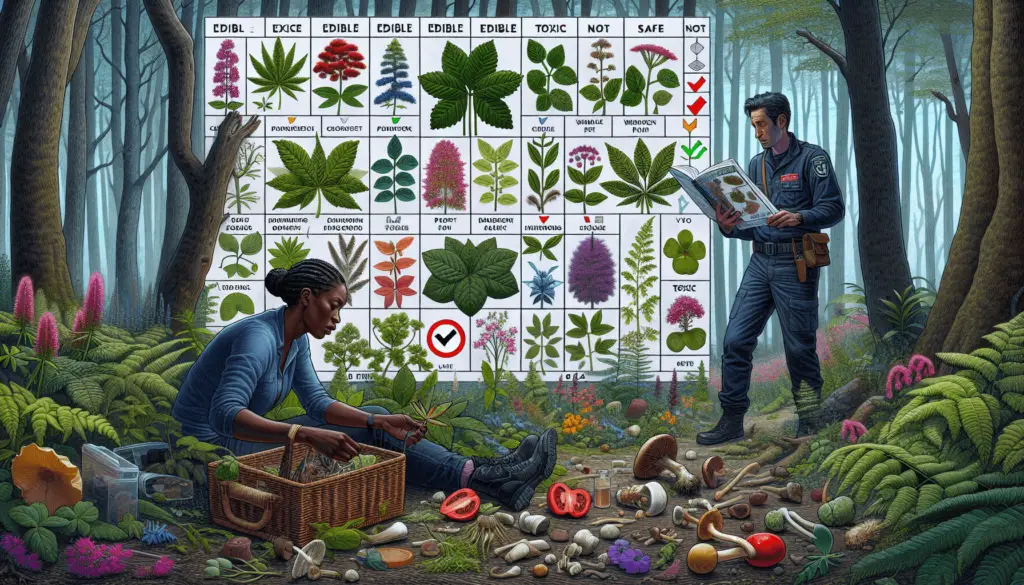Imagine you are out in the wilderness, surrounded by lush greenery and the beauty of nature. As you explore, you can’t help but wonder which of these plants are edible and which could potentially be harmful. Don’t worry, because in this article, we will guide you on how to easily identify edible plants in the wild. From distinctive features to useful tips and tricks, you’ll soon have the knowledge and confidence to forage for your own delicious and safe meals amidst nature’s abundant pantry. So let’s get started on this exciting adventure of discovering the wonders of edible plants in the wild!
Importance of Identifying Edible Plants in the Wild
Ensuring Food Security in Survival Situations
In survival situations, knowing how to identify edible plants becomes crucial for ensuring food security. When you find yourself in the wild without access to conventional food sources, being able to forage for edible plants can mean the difference between hunger and nourishment. By expanding your knowledge of edible plants, you can increase your chances of finding sustenance and surviving in challenging circumstances.
Utilizing Local Resources
Identifying edible plants in the wild allows you to utilize the resources available in your local surroundings. The indigenous plants found in different regions have evolved to thrive in their specific ecosystems, making them adapted to local soil, climate, and conditions. Being able to recognize and utilize these plants ensures that you make the most of the natural resources around you, reducing the need for imported or cultivated food sources.
Exploring Indigenous Food Sources
Identifying edible plants in the wild offers a unique opportunity to explore and connect with indigenous food sources. Many cultures around the world have a rich history of utilizing native plants for sustenance. By learning about and incorporating these plants into your diet, you not only gain access to diverse and nutritious food options but also develop an understanding and appreciation for the indigenous knowledge and traditions tied to these plants.
Understanding Edible Plant Characteristics
Study Plant Families
To effectively identify edible plants in the wild, it is important to study plant families. Plants that belong to the same family often share similar characteristics, making it easier to locate and recognize edible species. By familiarizing yourself with the identifying traits of various plant families, you can quickly narrow down the potential edible options based on their visual attributes.
Recognize Common Edible Plant Parts
Different edible plants have different parts that are safe for consumption. While some plants have edible leaves, others may have edible flowers, fruits, stems, or roots. Understanding the specific plant parts that are safe to eat is essential for accurate identification. Additionally, recognizing the distinguishing characteristics of these edible parts can further aid in identification and reduce the risk of misidentifying poisonous look-alikes.
Identify Poisonous Look-alikes
One of the challenges of identifying edible plants is the presence of poisonous look-alikes. Some plants may closely resemble edible species but can be toxic or even lethal if consumed. It is crucial to be able to differentiate between these look-alikes and the edible plants you are seeking. Paying close attention to specific characteristics such as color, shape, texture, and scent can help you avoid potentially dangerous mistakes.

Developing Field Identification Skills
Research Local Flora
To enhance your field identification skills, it is important to research the local flora. Different regions have unique plant species, and knowing which plants are native to your area can provide a starting point for your edible plant identification journey. Researching the local flora can help you familiarize yourself with the plants you are likely to encounter and guide your efforts in identifying edible options.
Practice Observation and Documentation
Observation and documentation are key skills for identifying edible plants in the wild. Take the time to observe the plants around you, noting their physical characteristics, growth patterns, and any distinguishing features. By documenting your findings through sketches, photographs, or written notes, you can create a valuable resource for future reference. Through consistent practice, your observation skills will improve, allowing for more accurate plant identification.
Use Field Guides and Apps
Field guides and mobile applications can be invaluable tools for identifying edible plants in the wild. These resources provide detailed information, photographs, and illustrations to aid in plant identification. When venturing into the wilderness, carrying a reliable field guide specific to your region or utilizing plant identification apps can increase your confidence in identifying edible plants and reduce the risk of misidentification.
Examining Plant Features for Identification
Leaf Characteristics
The characteristics of leaves play a significant role in identifying edible plants. Take note of the shape, color, texture, and arrangement of leaves. Some edible leaves may have distinct patterns or unique features such as serrated edges or fine hairs. By familiarizing yourself with the specific leaf characteristics of edible plants, you can enhance your ability to differentiate them from other non-edible plants.
Flower and Fruit Structures
Flowers and fruits can provide vital clues for identifying edible plants. In some cases, the flowers themselves may be edible, while in others, they indicate the presence of edible fruits. Pay attention to the size, color, and arrangement of flowers and fruits. Additionally, examine the structure of the fruit, noting whether it is a berry, seed pod, or drupe. Gaining familiarity with these characteristics increases your chances of correctly identifying edible plants.
Root Systems and Growth Patterns
Examining root systems and growth patterns can also aid in the identification of edible plants. Some edible plants have distinct root systems, such as taproots or fibrous roots, which can be valuable identifiers. Additionally, understanding the growth patterns of plants, such as whether they are tall and erect or low-lying and spreading, can further narrow down your identification process. By considering these factors, you can gather more information to confidently identify edible plants.

Testing for Edibility
Performing a Skin Test
Before consuming any part of an edible plant, it is important to perform a skin test. Rub a small section of the plant, such as its leaves or stems, against your skin and wait for at least 15 minutes. If you experience any adverse reactions, such as itching, redness, or a rash, it is crucial to avoid consuming that particular plant, as it may not be safe for your body.
Conducting a Sensory Test
To further test for edibility, conduct a sensory test. Start by touching and smelling different parts of the plant, such as its leaves, flowers, or fruits. Edible plants typically have a pleasant scent and do not produce a strong or off-putting odor. Next, take a tiny nibble of the plant and hold it in your mouth for a few moments, without swallowing. Note any unusual tastes, sensations, or discomfort. If the plant tastes excessively bitter, has a burning sensation, or causes any adverse reactions, it is best to avoid consuming it.
Using the Universal Edibility Test
In situations where you are uncertain about the edibility of a plant and need a more comprehensive test, you can use the Universal Edibility Test. This test involves a series of steps, including observing for any immediate negative reactions, preparing the plant in various ways, and consuming it in small increments over a period of time. It is essential to carefully follow the instructions of the Universal Edibility Test to minimize the risk of consuming potentially harmful plants.
Common Edible Plants in the Wild
Dandelion
Dandelions are widely recognized and readily available edible plants in the wild. The young leaves can be added to salads or cooked as a nutritious green. The flowers can be used to make dandelion tea or infused into honey for a flavorful treat. The roots can also be dried and ground to make a substitute for coffee.
